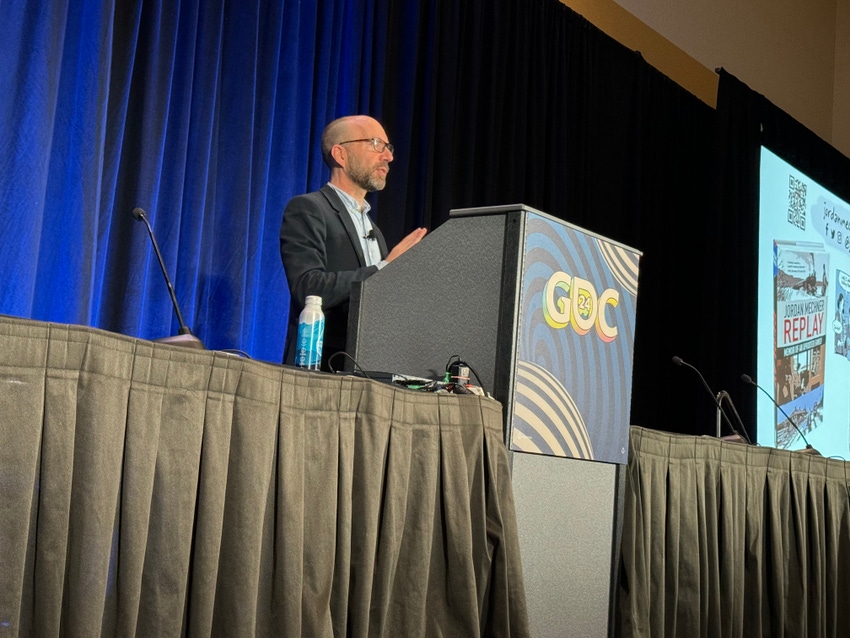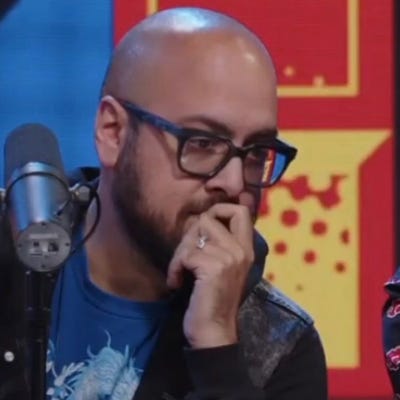
Read More from GDC 2024 | Keep up with the latest game industry event coverage from GDC 2024, including news, talks, interviews, and more from the Game Developer team.
Jordan Mechner recounts the tale of creating Karateka from home
Preeminent game developer Jordan Mechner created Karateka as a college student in an age where there were mostly no rules about how to create a video game, let alone one that became such a touchstone for the medium to come.

At GDC 2024 in San Francisco, luminary game developer Jordan Mechner spoke at length about the creation of (one of) his first major works and a foundational stone of modern-day gaming, Karateka. Mechner, who was also behind seminal titles like Prince of Persia and The Last Express, used images from a comic book-styled book he is publishing about his early years in the industry in combination with his actual journal entries from the mid-80s to recall the struggles and triumphs of getting Karateka to market.
Mechner started the talk by discussing Super Invader (1979), which he called the first arcade game that was actually fun. The only credits Mechner could see on it was the name "M. Hata," the sole Japanese programmer behind the Space Invaders clone. Inspired, Mechner created his own version of Asteroids at home and shopped it to a publisher who surprisingly agreed to publish it, only to get cold feet as Atari began pursuing legal action against home ports of arcade games. This would mark Mechner's actual first game, but also his first unpublished one.
Following that was Deathbounce, his second unpublished game, and yet another clone of Asteroids. During that game’s development, Mechner started keeping a journal in a notebook, because his Apple II did not have lowercase letters or enough internal space to support long documents, and noted in said journal that he had been inspired by the 1981 game Swashbuckler. This inspiration led to Karateka. But he couldn’t just leap straight into making the title, as he did with his previous two games.
“Before I could make any game, I had to make the tools to make the game.”
As a college student, Mechner was unable to find proper time to work on Karateka. He was also going to school to pursue an education in film, which informed his story focus for what he wanted Karateka to be. Unlike most games at the time, Karateka was planned to have a story that unfolded as you played through. Mechner also wanted the animations to have a film-like quality to them, leading him to record his mother’s karate teacher, at her suggestion, for the specific moves. For the protagonist, he also filmed his father running through the woods dressed in a gi, and sister as the Princess, tracing over the frames with a Versawriter.
"...We just made things up..."
"In the 1980s, this field was so new that we just made things up as we went along."
Eleven months into the game’s development, Mechner was hoping to wrap things up. Karateka had already taken the place of Deathbounce in his heart, but he was looking to finish development of the game before the summer ended and he returned to school. He did not hit this self-imposed deadline, as he realized the game was getting too complicated for its own good and he needed to simplify it further.
Along with simplifying the control scheme, Mechner also realized after a conversation with his father that the game needed a conflict of interest to be more interesting. This conflict came in the form of a hawk that added suspense to the gameplay, appearing between the various guards that blocked progress to get in a hit or two on the player character. A similar revelation came in the form of comic book hit effects to provide visual feedback, cueing players in to who was actually winning a fight.
The importance of good composition
Mechner also came to the conclusion that music makes the act of playing a video game more exciting. Without much in the way of musical inclination himself, Mechner’s dad agreed to compose the soundtrack to Karateka.
Eventually, as development wrapped up, Mechner wrote letters to Broderbund and Electronic Arts. The latter never replied, but Broderbund sent a letter inviting Mechner to their development studio in California, which Mechner attended during his summer break. During this visit, he worked with Gene Portwood (a former animator at Disney) and Lauren Elliott, whom Mechner described as “game creators who didn’t program, making them essentially the first game designers.”
Portwood and Elliott helped Mechner refine aspects of Karateka in what was called “The Rubber Room”, including adding a panther enemy that was eventually cut—which Mechner likened to the Sand Griffin from Prince of Persia: Sands of Time, which was cut for similar time reasons—and overall tuning of the game. Mechner relayed how the developers told him stories about how the golden age of video games was already over in the early 1980s and that the industry was entirely about the money now.
At one point, Mechner approached his boss at Broderbund to try and sell him on a joke.
“So there was this thing called the lookup table, which essentially pinpointed where a pixel was supposed to be. And they showed me how to invert the lookup table, which if you did that, would make the game upside down. I took this to my boss at Broderbund and argued that we should print this inverted version on Side-B of the disk, which companies didn’t like to do, because you would have to have someone physically flip the disk over on the assembly line and print on the other side. I said, wouldn’t it be funny if people put the disk in upside down and got an upside down version of Karateka? And then they would call customer service, and customer service would say ‘Have you tried flipping the disk around, sir?’ and they would try it and go ‘Oh, okay,’ and then think that’s how software works. And somehow, he agreed to do it!”
Much to the surprise of everyone at Broderbund, who expected he would drop out of school and remain at the studio, Mechner returned to college after the summer was over. The game came out in time for Christmas, but was off to a slow sales start and didn’t look like it would be picking up steam anytime soon.
Despite that, Mechner received a piece of fan mail from a seventeen-year-old John Romero, who loved the game and asked a number of technical questions. Mechner, to his knowledge, wrote back with appreciative words. Decades later, Romero mentioned to Mechner in an elevator at GDC that he had written to him and Mechner went home and managed to find the letter.
In April 1985, the Billboard charts had started reporting on software sales and Mechner received a notice from Broderbund to take a look at that month’s listing. He concluded the talk by showing the Billboard chart with Karateka somehow topping the list, launching his storied career for decades afterward.
Game Developer and GDC are sibling organizations under Informa Tech.
About the Author(s)
You May Also Like









